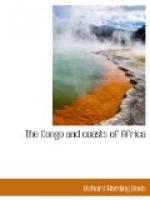A skipper going ashore to drum up trade was a novel spectacle. Imagine the captain of one of the Atlantic greyhounds prying among the warehouses on West Street, demanding of the merchants: “Anything going my way, this trip?” He would scorn to do it. Before his passengers have passed the custom officers, he is in mufti, and on his way to his villa on Brooklyn Heights, or to the Lambs Club, and until the Blue Peter is again at the fore, little he cares for passengers, mails, or cargo. But the captain of a “coaster” must be sailor and trader, too. He is expected to navigate a coast, the latest chart of which is dated somewhere near 1830, and at which the waves rush in walls of spray, sometimes as high as a three-story house. He must speak all the known languages of Europe, and all the unknown tongues of innumerable black brothers. At each port he must entertain out of his own pocket the agents of all the trading houses, and, in his head, he must keep the market price, “when laid down in Liverpool,” of mahogany, copra, copal, rubber, palm oil, and ivory. To see that the agent has not overlooked a few bags of ground nuts, or a dozen puncheons of oil, he must go on shore and peer into the compound of each factory, and on board he must keep peace between the Kroo boys and the black deck passengers, and see that the white passengers with a temperature of 105, do not drink more than is good for them. At least, those are a few of the duties the captains on the ships controlled by Sir Alfred Jones, who is Elder and Dempster, are expected to perform. No wonder Sir Alfred is popular.
Our first port of call was Landana, in Portuguese territory, but two ships of the Woermann Line were there ahead of us and had gobbled up all the freight. So we could but up anchor and proceed to Libreville, formerly the capital of the French Congo. At five in the morning by the light of a ship’s lantern, we were paddled ashore to drum up trade. We found two traders, Ives and Thomas, who had waiting for the Nigeria at the mouth of the Gabun River six hundred logs of mahogany, and, in consequence, there was general rejoicing, and Scotch and “sparklets,” and even music from a German music-box that would burst into song only after it had been fed with a copper. One of the clerks said that Ives had forgotten how to extract the coppers and in consequence was using the music-box as a savings bank.
In the French Congo the natives are permitted to trade; in the Congo Free State they are not, or, rather, they have nothing with which to trade, and the contrast between the empty “factories” of the Congo and those of Libreville, crowded with natives buying and selling, was remarkable. There also was a conspicuous difference in the quality and variety of the goods. In Leopold’s Congo “trade” goods is a term of contempt. It describes articles manufactured only for those who have no choice and must accept whatever is offered. When your customers must take what you please to give them the quality of your goods is likely to deteriorate. Salt of the poorest grade, gaudy fabrics that neither “wear” nor “wash,” bars of coarse soap (the native is continually washing his single strip of cloth), and axe-heads made of iron, are what Leopold thinks are a fair exchange for the forced labor of the black.




